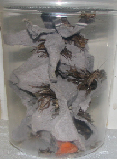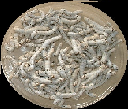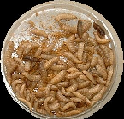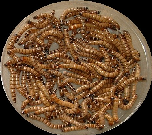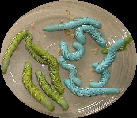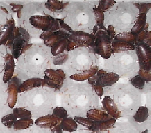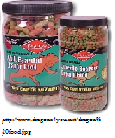Feeding and Watering
General
Bearded Dragons are omnivores. They require both insects and vegetables/fruit. Some also feed pinkie mice.
Note: Leave lights on for at least two hours after the last meal of the day for optimal digestion. Some Bearded Dragons will also refuse to eat in the morning if they are not warm yet.
Ratios of Salad vs. Insects
For a Bearded Dragon more than a year old, there should be roughly 70% salad and 30% insects. At this age a Bearded Dragon should get 50 crickets OR 30 worms a week. Obesity is a problem in this age bracket. So a good feeding schedule would be in threes. One day salad, one day insects, one day nothing, and then repeat.
For a Bearded Dragon less than a year old, there should be 70% insects and 30% salad in their diet. A young Bearded Dragon should get between 30-80 appropriately sized crickets (smaller than the space between the Bearded Dragon's eyes) a day. Before the age of 2 to 3 months, young Bearded Dragons should be fed 3-5 times a day. Between 3 and eight months, they should be fed twice a day. After eight months, they can be fed once a day.
Insects
There are many types of feeder insects with varying health and worth. I will list some of the safer and healthier ones here.
Note on gut-loading: Feed your insects well at least 24 hours in advance of when they are fed off. This is called gut-loading. Some feeders are nutritionally worthless if they are not gut-loaded.
Note on outside insects: Do NOT feed insects from outside. Not only may they have gotten into fertilizers or poisons, but they almost certainly have parasites that they can pass on to your Bearded Dragon. Some may also be deadly poisonous in and of themselves, like lightning bugs/fireflies are, which will kill your pet almost instantly, every time. Insects from outside simply aren't a safe option. Buy your insects from reputable pet stores or insect dealers.
|
Crickets |
|
Silkworms |
|
Phoenix Worms/Calci-Worms |
|
Superworms |
|
Roaches- Deathhead, Lobster, Dubias, and Discoid |
|
Locusts |
|
Occasional/Treat Insects |
Salad
|
A good salad should consist mostly of dark leafy greens and vegetables. Good greens include Collard Greens, Turnip Greens, and Mustard Greens. You should aim for 2-3 types of Greens and 2-3 types of vegetables in the salad, with as much variety as possible being ideal. Fruit may be offered one or two times a week. Cut the salad ingredients into bite-sized pieces by hand or with a food processor before offering it to your Bearded Dragon. |
Supplementation A.K.A. 'Dusting'
|
|
Commercial Bearded Dragon Food
|
Currently consensus is that they are a good supplement, but are not truly adequate for making up the entirety of a Bearded Dragons diet. |
Water
Although Bearded Dragons come from a dry environment, they still need water. You can give them water in several different ways:
--Mist them about 2-4 times a day. To mist, get a garden-variety water bottle and set it to the lightest/mist setting. Then gently mist above your Bearded Dragon so that the water falls down on him like a gentle rain. This allows your Bearded Dragon to lap up the falling/fallen water.
--Drip water on their nose till they’re done (this is also great for bonding).
--Give them daily baths or you can use another method for daily water and give them baths occasionally. To give baths, fill either a large container, a sink, or a bath tub with warm water, about the same temperature you'd use for a baby, up to the 'elbows' for younger Bearded Dragons and up to the shoulders for adults. You may want to put a cloth on the bottom for traction, this will also greatly comfort Bearded Dragons who are nervous about baths. Then just gently splash the water over them and let them soak for 10-15 minutes. If they have feces or something caked on, use a soft-bristled tooth brush to get it off. Dry them off thoroughly after their bath.
--Some Bearded Dragons will drink from water bowls, but most don’t recognize standing water as drinkable. Don’t assume that because you have a water bowl in there means they are getting water. But just because a Bearded Dragon doesn't naturally recognize standing water doesn't mean you have to give up on their drinking from a water bowl. You can train a Bearded Dragon to drink from a water bowl with very little difficulty.
Pinkies - For Experienced Keepers Only
|
|
Things that are Poisonous To Bearded Dragons
- Lightning Bugs/Fireflies
- Rhubarb
- Avocado
For a more complete list, check: Melissa Kaplan's "Plant Listings"
Signs a Reptile has been poisoned: Melissa Kaplan's "Signs of Ingestion of Toxic Substances"
